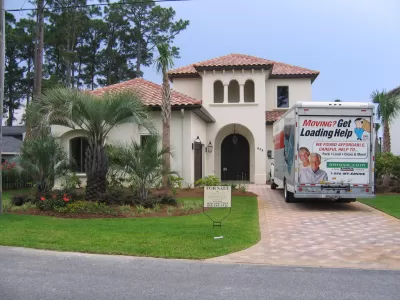How will millennial homebuyers change suburbia, or will they? Realtors observe that millennials relocating from the city look for parts of their urban lifestyle, e.g., walkable neighborhoods, yet they also have traditional suburban tastes.

What we know for sure is that they are moving to suburbia: "Folks in their 20s and early 30s make up the largest segment of home buyers in the nation, according to the National Association of Realtors (NAR)," writes freelance reporter Nova Safo for American Public Media's Marketplace from Chicago, and heard on the podcast below. And that's for the third consecutive year.
An NAR survey finds that millennials make up a third of home buyers (baby boomers do, too, but they are a few percentage points behind). But, millennials also make up two thirds of first-time home buyers, according to the NAR.
"[Millennials] are growing up," said said Jessica Lautz, NAR's managing director of survey research.
And they are following in much of the same patterns of previous generations. "They are becoming homebuyers. They are saving. They are getting married. They are having kids. Much like all of us have done in past generations."
What distinguishes millennial homebuyers from other generations in the market is that they "don't want to move to just any suburban neighborhood," observes Safo. Walkable neighborhoods and public transit are major attractions for many in this generation.
"People really kind of want the anti-suburb suburb," said Bernstein. "[H]er clients often want to preserve at least some elements of their urban lifestyle in their new suburban neighborhoods."
These desires have triggered changes in some suburbs, especially those closest to urban centers. They are experimenting with repurposing malls and parking lots into green space, creating retail hubs, and investing in public transportation, among other efforts.
"After all, if millennials can reinvent city living, why not suburbs too?" concludes Safo.
Articles on how urban realty companies help millennials find homes in the suburbs can be found below in "related links."
FULL STORY: A move toward three bedrooms and two baths

Study: Maui’s Plan to Convert Vacation Rentals to Long-Term Housing Could Cause Nearly $1 Billion Economic Loss
The plan would reduce visitor accommodation by 25,% resulting in 1,900 jobs lost.

North Texas Transit Leaders Tout Benefits of TOD for Growing Region
At a summit focused on transit-oriented development, policymakers discussed how North Texas’ expanded light rail system can serve as a tool for economic growth.

Why Should We Subsidize Public Transportation?
Many public transit agencies face financial stress due to rising costs, declining fare revenue, and declining subsidies. Transit advocates must provide a strong business case for increasing public transit funding.

How to Make US Trains Faster
Changes to boarding platforms and a switch to electric trains could improve U.S. passenger rail service without the added cost of high-speed rail.

Columbia’s Revitalized ‘Loop’ Is a Hub for Local Entrepreneurs
A focus on small businesses is helping a commercial corridor in Columbia, Missouri thrive.

Invasive Insect Threatens Minnesota’s Ash Forests
The Emerald Ash Borer is a rapidly spreading invasive pest threatening Minnesota’s ash trees, and homeowners are encouraged to plant diverse replacement species, avoid moving ash firewood, and monitor for signs of infestation.
Urban Design for Planners 1: Software Tools
This six-course series explores essential urban design concepts using open source software and equips planners with the tools they need to participate fully in the urban design process.
Planning for Universal Design
Learn the tools for implementing Universal Design in planning regulations.
City of Santa Clarita
Ascent Environmental
Institute for Housing and Urban Development Studies (IHS)
City of Grandview
Harvard GSD Executive Education
Toledo-Lucas County Plan Commissions
Salt Lake City
NYU Wagner Graduate School of Public Service





























